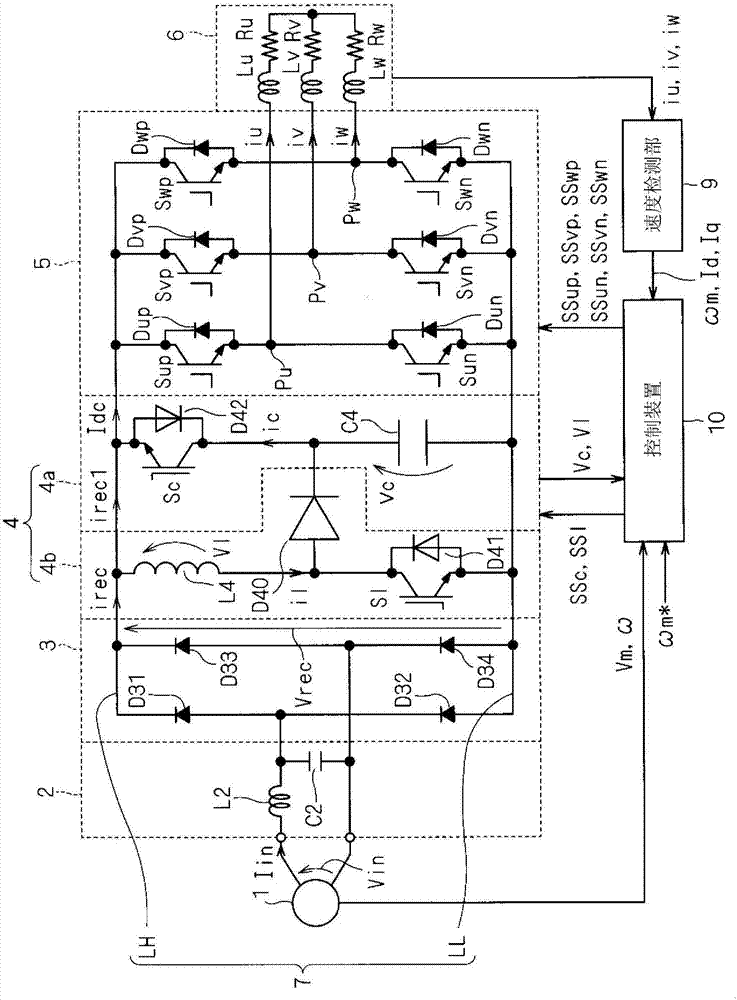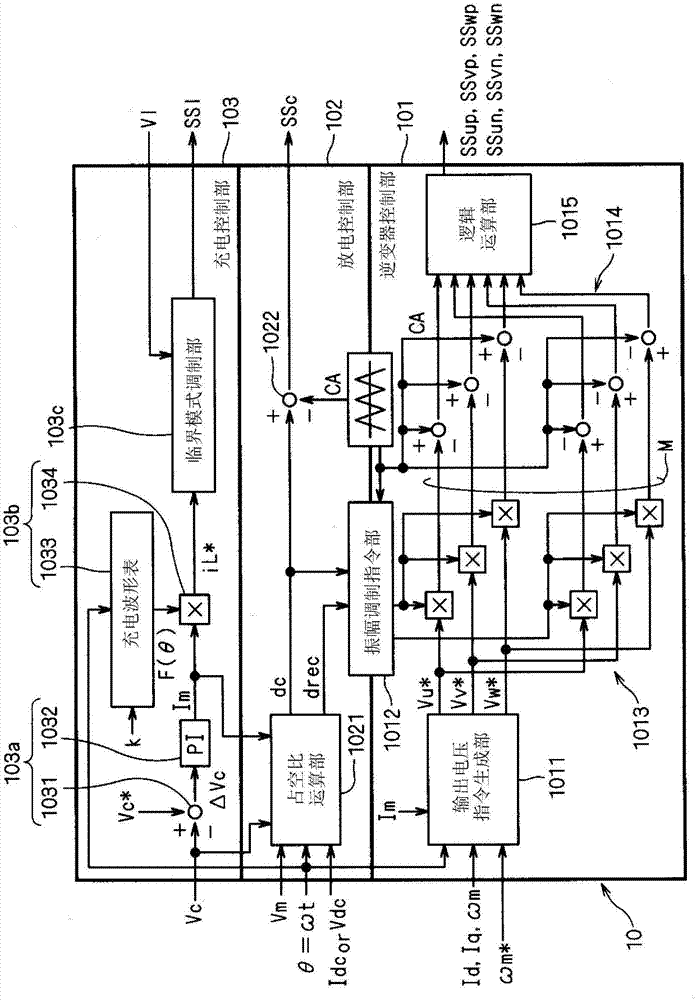Control device for direct power converter
A technology of power converters and control devices, applied in high-efficiency power electronic conversion, output power conversion devices, control/regulation systems, etc., can solve problems such as reactor current discontinuity
- Summary
- Abstract
- Description
- Claims
- Application Information
AI Technical Summary
Problems solved by technology
Method used
Image
Examples
no. 1 Embodiment approach
[0150] The operation of the first embodiment and the direct type power converter introduced in Patent Document 2 will be described in comparison.
[0151] In the technology shown in Patent Document 2, in order to eliminate the above-mentioned AC component Pin^, different controls are alternately performed for each quarter cycle ((1 / 4) cycle) of the single-phase AC voltage Vin (hereinafter, also referred to as Such control is simply referred to as "quarter cycle control"). Specifically, the control of Pl=Pin^, Pc=0 and the control of Pl=0, Pc=-Pin^ are alternately performed every quarter cycle of the single-phase AC voltage Vin. Thus, during the whole period, Pdc=Pin+Pc-Pl=Pin-Pin^=(1 / 2)·Vm·Im holds true, avoiding power pulsation. This corresponds to the case of k=1 in equation (6).
[0152] In this application, following the example of Patent Document 2, the period during which the received power P1 is received from the DC link 7 (this is the period during which the cosine v...
no. 2 Embodiment approach
[0191] In the second embodiment, a case will be described in which the distribution ratio k, the rectification duty ratio drec, and the discharge duty ratio dc are different from the values employed in the first embodiment.
[0192] The rectification duty ratio drec and the discharge duty ratio dc shown in equations (11) and (12) can make the DC voltage Vdc constant. If Vrec=Vm·|sin(ωt)| is taken into consideration, it can also be understood that Equation (7) holds true identically.
[0193] Among them, drec≤1, and during the grant period, |sin(ωt)|≤1 / √2, therefore, from the rectification duty cycle during the grant period shown on the right side of equation (12), it can be known that as long as the DC voltage Vdc is constant , then the value will not exceed 1 / √2 times the amplitude Vm.
[0194] Therefore, in this embodiment, a technique for increasing the ratio R of the DC voltage Vdc to the amplitude Vm (hereinafter referred to as "voltage utilization ratio R") is introdu...
no. 3 Embodiment approach
[0263] (h-1) Duty cycle setting.
[0264] The third embodiment does not employ the "quarter cycle control" employed in the first and second embodiments. That is, in the present embodiment, the rectification duty ratio drec and the discharge duty ratio dc are determined so that no distinction is made between the acceptance period and the grant period. However, as in the first and second embodiments, the rectification duty ratio drec and the discharge duty ratio dc do not depend on the distribution ratio k.
[0265] Specifically, the rectification duty cycle drec and the discharge duty cycle dc are determined by equations (27) and (28), respectively.
[0266] Formula 27
[0267]
[0268] Formula 28
[0269]
[0270]As will be described later, the voltage Vc at both ends fluctuates, but is controlled to be approximately constant. Therefore, the discharge duty ratio dc is proportional to 1+cos(2ωt), and is basically based on a frequency twice that of the single-phase AC v...
PUM
 Login to View More
Login to View More Abstract
Description
Claims
Application Information
 Login to View More
Login to View More - R&D
- Intellectual Property
- Life Sciences
- Materials
- Tech Scout
- Unparalleled Data Quality
- Higher Quality Content
- 60% Fewer Hallucinations
Browse by: Latest US Patents, China's latest patents, Technical Efficacy Thesaurus, Application Domain, Technology Topic, Popular Technical Reports.
© 2025 PatSnap. All rights reserved.Legal|Privacy policy|Modern Slavery Act Transparency Statement|Sitemap|About US| Contact US: help@patsnap.com



